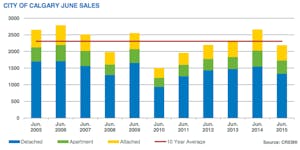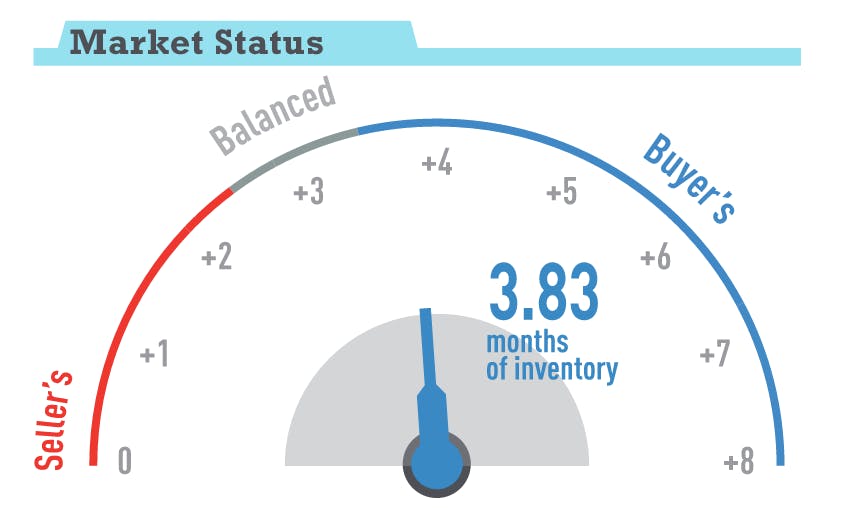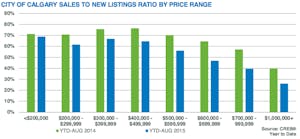Detached prices stabilize in soft market
For the first time in two years, sales activity in October resembled normal levels. City-wide sales totaled 1,644 units, which is an increase of nearly 16 per cent over last year.
“The shift in sales activity this month is likely related to the new mortgage rule changes, inventory gains in the lower price ranges and further price adjustments,” said CREB® chief economist Ann-Marie Lurie. “The combination of all these factors may have encouraged some purchases to take advantage of the market conditions, particularly in the lower price ranges. However, with several factors at play, the monthly shift in demand may be temporary and will need to be monitored over the next several months.”
Sales activity rose across all product types in comparison to last year, but the largest gain in sales occurred in the detached sector at 18 per cent.
There was a noticeable shift in sales activity by price range in October. In the detached market, homes priced between $300,000 and $400,000 saw the largest improvement in sales, while attached and apartment sales growth was mainly occurring in the lower price ranges.
“This year has been a challenge for many sellers,” said CREB® president Cliff Stevenson. “So when we have a rise in sales, it means more buyers got into the market and more sellers got out, which is a positive for consumers on both sides of the transaction.”
“Sales activity changed direction in October, but we need to see some consistency next month and the month after to call it a trend,” adds Stevenson. “For now it’s a nice building block.”
Despite the monthly rise, year-to-date sales activity in all sectors remained lower than last year’s levels and well below longer term trends. In fact, year-to-date sales activity has totaled 15,642 units, which is 6.3 per cent below last year’s levels. While increased activity in the lower price ranges had a greater impact on the average and median price, benchmark prices once again edged down in October.
The city-wide unadjusted benchmark price totaled $438,900, or 0.34 per cent below last month and four per cent below last year’s levels.
Since the start of the downturn, home prices have declined from a low of 3.8 per cent in the detached market to a high of 9.4 per cent in the apartment condominium sector. And, despite the rise in October sales, monthly prices continued to decline for most product types in the market.
Click on the following link to view the full .pdf report! October-2016-statistics-package-for-the-city-of-calgary

Click on this following link to view the full .pdf report for the Regional Statistics: october-2016-regional-statistics-package-for-calgary-and-area
calgary market statistics
YYC March 2016 Team Penley McNaughton Newsletter
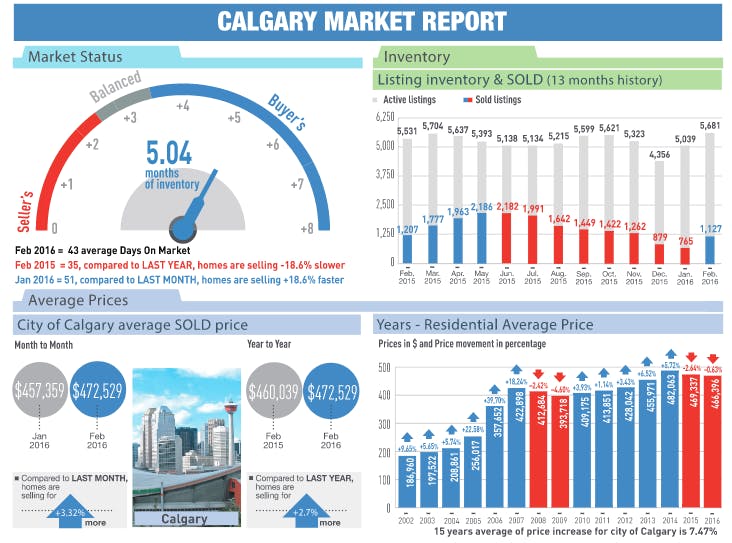
Click on the following link to view the full Team Penley McNaughton’s YYC Newsletter and view the most current February 2016 statistics!

Hard hit – calgary market struggling…
The latest data confirms agents’ fears in one hard-hit market.
Housing in Calgary will be “weak,” according to the Calgary Real Estate Board which cites continued economic volatility as the reason.
“As we move into the second year of this environment, we expect to see additional housing supply pressure and further price declines,” CREB Chief Economist Ann-Marie Lurie said in a release. “Weakness in the energy sector is overshadowing all aspects of our economy and with more people looking for work and fewer opportunities; we could see some families making adjustments to their housing situation.”
Sales activity is expected to decline 2.2% to 18,416 units, according to the association. The average price is expected to decline by 3.44% to $438,652.
“Market intelligence really matters in today’s operating environment. Pricing trends have and will continue to vary depending on product type, price range and location,” CREB president Cliff Stevenson said. “Sellers in this market need to have a good understanding of activity within their specific niche of the market. This is where a real estate professionals can really help navigate market conditions and real estate options, which are always unique to each consumer.”
These predictions echo concerns from agents in the area.
“What can we expect next year in Alberta? That’s a good question; I wish I had a crystal ball,” George Bamber, broker/owner of Century 21 Bamber Realty, recently told REP. “I’d expect sales to be similar to 2015; I don’t see them being much more depressed, but I don’t see them returning to pre-2014 levels.”

Regional sales outpace long-term averages
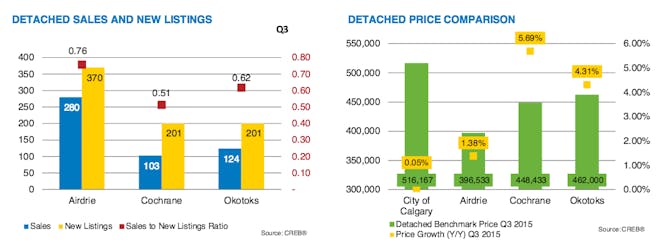
CALGARY REGIONAL HOUSING MARKET STATISTICS
Prices ease as expected
Inventories rise as sales activity softens further
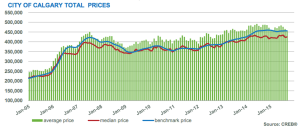
Following four months of relative stability, unadjusted benchmark prices eased as expected in September to $456,100, a 0.26 per cent decline compared with last year.
Most of this aggregate moderation was due to price declines in the apartment sector brought on by higher-than-average inventory levels.
“Overall sales activity relative to new listings caused a softening in absorption rates, which resulted in inventory gains and ultimately placed moderate downward pressure on pricing,” said CREB® chief economist Ann-Marie Lurie.
Residential sales in the city totaled 1,448 units in September, well below typical activity levels for this time of year. Year-to-date Calgary sales remained below both the five- and 10-year year averages by a respective 10 and 26 per cent.
“Rising unemployment and persistent weakness in the local economy is impacting housing demand,” said Lurie. “However, unlike earlier this year when consumers were reacting to uncertainty, recent activity reflects current economic conditions.”
While all property types recorded a notable drop in the sales-to-new- listings ratio, both the apartment and attached segments saw the most significant declines. Ratios in both categories dropped to the 40 per cent range, while months of supply pushed up to 4.95 and 4.35, respectively.
In comparison, the detached category saw its ratio hover around 50 per cent in September and months of supply settle at 3.32.
Elevated inventory levels in the apartment segment, in particular, are the result of moderate listing declines relative to sales activity, noted Lurie. Year-to-date apartment sales have fell by 32 per cent, while listings have dropped by just seven per cent.
As a result, the apartment benchmark price totaled $290,600 in September, a 1.19 per cent decline over last month and 2.71 per cent below last year.
CREB® president Corinne Lyall said that while the apartment sector now favours buyers with added selection and attractive pricing, other factors will continue to play into purchase decisions.
“While the apartment sector offers more choice, not all units are created equal,” she said. “When considering apartment condominiums, it’s important to understand that the corporate and physical health of the building can also influence both buying and selling decisions in this type of market.”
Despite higher months of supply, typical home prices in both the detached and attached sectors remained relatively unchanged in September, totaling $517,200 and $357,000, respectively.
Although citywide inventory levels remained elevated compared to activity seen in the past three years, Lyall noted they still were well below highs recorded during the previous economic downturn in 2008/09.
“There is no question that we have seen a shift in our local housing market conditions, but it needs to be put in perspective,” she said.
Aggregate prices have eased by one per cent from the beginning of the year, a moderate correction when compared against the aggressive gains last year that averaged more than nine per cent, noted Lyall.
Click Here for the full .pdf of the CALGARY REGIONAL HOUSING MARKET STATISTICS
Check out our newsletter: YYC Newsletter Sept 2015
Spotlight on Luxury – RE/MAX Collection Report
Sales of homes priced over $1 million were up year-over-year in Toronto, Vancouver, Montreal and Victoria in the first seven months of the year. Calgary was the exception; sales in the $1 million range decreased 28 per cent over the same period in 2014.
In Canada’s two largest luxury markets, sales of homes $3 million and up saw impressive gains. In the Greater Toronto Area, sales in this range increased by 119 per cent and in Greater Vancouver by 79 per cent between January 1 and July 31.
The increase of sales at the top-end of the luxury market can be attributed to two factors. One is overall price appreciation in both markets, driven by low inventory and high demand for single-family homes that hasled to more homes meeting the higher dollar threshold. A second factor is high demand for luxury homes from foreign buyers in both markets.
In Calgary, a healthy 2.3 to 2.5 months’ supply of inventory in the $1 million plus range has brought a more balanced market to the city. Luxury buyers are not witnessing a notable decrease in price; however, there is less pressure for buyers during the negotiation process. With more inventory available, conditions like home inspection and financing, which were rarer when buyers were frequently in a competing offer situation, have become part of the normal negotiation process again.
RE/MAX brokers and agents reported that foreign buyers have continued to drive demand in the Vancouver and Toronto luxury markets in the first half of 2015. These buyers, primarily from China, are typically families with children who are relocating to Canada to live. They’ve chosen Canada for its stable economy and high quality of life, and their real estate decisions are strongly influenced by proximity to good schools.
Although foreign buyers are less active in Montreal’s luxury market compared to Toronto and Vancouver, RE/MAX brokers and agents have reported a substantial increase in foreign buyers in Montreal during the first seven months of 2015. Its relative affordability, aided by the strength of the yuan compared to the Canadian dollar during this period, make the city a
good value proposition for foreign buyers.
In regions where condominiums are a significant part of the luxury market, sales of condominiums priced over $1 million rose year-over-year. Montreal, Toronto and Vancouver all saw an increase of high-end condominium sales. While demand in the luxury freehold market was driven primarily by families, luxury condominium buyers tend to be Baby Boomers who are downsizing during retirement. These buyers tend to spend part of their time in a second home or travelling, and choose condominiums for access to luxury amenities without the maintenance required of a house.
Based on interviews with RE/MAX brokers and associates, luxury market trends seen in Canada’s major markets during the first seven months of the year are expected to continue through the end of 2015. Click Here or on the image below for the full report:

Calgary Regional Housing Market Statistics – August 2015
Sales in the city declined by 27 per cent to 1,643 units last month relative to the same time last year, and 12 per cent below 10-year averages.
“Persistent weakness in the energy sector weighed on sales activity this month, which once again retracted to levels well below the norm for the city,” said CREB® chief economist Ann-Marie Lurie.
The residential unadjusted sales-to-new-listings ratio eased from 67 per cent in July to 60 per cent in August, contributing to a monthly rise in inventory levels to 5,146 units. Combined with weaker sales activity, months of supply pushed up to 3.13 months.
While every price range experienced fewer sales per new listing, homes in the higher price ranges saw the most significant decline in absorption rates compared to last year, noted Lurie.
Year-to-date new listings in the $600,000-plus category increased in share of activity compared to last year. However, sales activity in this price range represented 18 per cent of all the sales last month, down from nearly 20 per cent last year.
“With more options in the higher-end of the market, sellers will need to consider their competition as well as their goals regarding a sell date,” said CREB® president Corinne Lyall. “This will influence the pricing strategy they agree upon with their real estate professional.”
Lurie added that despite challenges near the top of the market, absorption rates in the under-$500,000 detached sector remained relatively tight and is likely causing some price trend discrepancies.
Despite weaker absorption rates, benchmark prices remained relatively stable, totaling $456,300 in August. Lurie credits this steadiness to both the detached and attached sectors, which have remained more balanced relative to the apartment sector.
The apartment sector continued to struggle with increased competition from competing properties during the month, as unadjusted months of supply rose to 4.3. Increased supply is ultimately weighed on pricing, as prices declined on a year-over-year basis by 1.44 per cent in August.
Overall, the combination of price declines and higher inventory levels in some segments of the market are influencing buying patterns in Calgary, said Lyall.
“Improved selection in these segments is giving buyers the opportunity to be discerning about their purchase decisions,” she said. “They may be weighing their options between resale and new product, along with what community fits their lifestyle.”
“Although market conditions affect consumers’ real estate decisions, so do their lifestyles. People move for a number of reasons, including proximity to work and schools, along with changes in family dynamics.”
Click Here for the Full August_2015_Monthly_Housing_Statistics
Calgary rental vacancies increase
The vacancy rate of rental properties in Calgary has increased due to greater supply of new homes.
Data from the latest census shows 12,526 vacant dwelling units, 3,211 more than a year ago. The vacancy rate is 2.6 per cent compared to 2.01 per cent in 2014.
There are also 12,998 units being built in Calgary, up 4,125 from last year.
Rent increases have eased as a result of the better supply levels.

Source REP: http://www.repmag.ca/market-update/calgary-rental-vacancies-increase-193788.aspx
CALGARY REGIONAL HOUSING MARKET STATISTICS – June 2015
Despite the 18 per cent year-over-year decline in June home sales, for a total of 2,183 units, transaction levels remain only five per cent below the 10 year average for June and three per cent above levels over the past five years.
“We’ve seen less concern from consumers lately,” said CREB® president Corinne Lyall. “One of the main reasons is that we haven’t seen the worst case scenarios play out in the energy and housing sectors.”
“Consumers who were waiting for wide-spread price declines have been surprised to see that it just hasn’t happened yet, and so they’ve decided to take advantage of the improved selection and lower lending rates,” said Lyall.
The level of new listings that came on the market in June totaled 3,122 units, resulting in the second month of elevated absorption rates, which placed downward pressure on inventory levels. The overall months of supply continues to remain balanced at 2.3 months.
With conditions remaining relatively stable in June, there was minimal pressure on home prices. The city-wide benchmark price totaled $455,400, a respective monthly and year-over-year gain of 0.29 and 0.13 per cent.
“Even though city-wide prices were essentially unchanged in June, it’s important to note that activity can vary significantly depending on community, property type and price range,” said Lyall. “Every transaction has its own unique features, which is why we always encourage consumers to discuss these differences with local experts.”
Second quarter results pointed towards more stability in the market. The year-over-year decline in sales activity eased from 32 per cent in the first quarter to 22 per cent in the second quarter. Meanwhile, the level of pullback of new listings outweighed the gains recorded in the first quarter, resulting in a year-to-date decline of nearly eight per cent.
While both sales and new listings have slowed for each property type within the city, the apartment sector continues to report the weakest absorption rates.
The weaker rates in this sector are now impacting prices. Despite last month’s improvement in price, the second quarter benchmark price was 0.81 per cent below levels recorded last year and 0.93 per cent below first quarter figures. Year-to-date unadjusted apartment averages continue to remain 1.65 per cent above last year’s levels.
In the detached segment, benchmark prices totaled $515,500 in June, slightly higher than last month and 0.4 per cent higher than June 2014 prices. Meanwhile, the year-to-date benchmark price for detached properties remained 3.44 per cent above last year’s figures.
Against this backdrop, the year-to-date average and median detached home price for Calgary has reported declines of 2.26 and 1.54 per cent city-wide. This doesn’t come as a surprise, given that the share of sales activity has declined in the higher price ranges.
“The housing market is showing some signs of stability right now,” said CREB® chief economist Ann-Marie Lurie. “However, there are several risk factors that could influence the market in the second half of the year,” said Lurie. “Many of these factors will be addressed in CREB®’s mid-year forecast update, which will be released at the end of July.”
Click Here to view the full .pdf Report!
